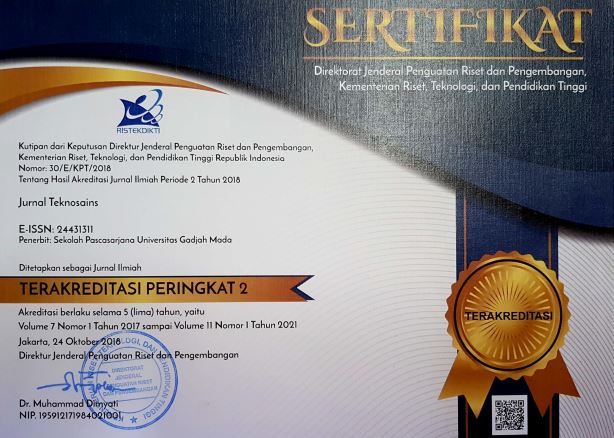Uji komparasi desinfektan septalkan, terralin, dan alkohol 70% terhadap daya sterilisasi permukaan kursi dental
Arif Andriyanto(1), Risma Dwi Irfanto(2), Heribertus Dedy Kusuma Yulianto(3*)
(1) Universitas Gadjah Mada
(2) Universitas Gadjah Mada
(3) Universitas Gadjah Mada
(*) Corresponding Author
Abstract
Cross-infection has the potential to occur in the Dental and Oral Hospital due to cross-transmission of pathogenic microbes through dental chair surfaces that are contaminated with microbes. This study aims to compare the effectiveness of three types of disinfectant Septalcan, Terralin, and 70% alcohol on the inhibition of pathogenic microbes originating from the oral cavity of patients who contaminate the surface of dental chairs in aerosol and non-aerosol clinics. Sampling of microorganisms was carried out using the technique of wiping/swab the surface of dental chairs in aerosol and non-aerosol clinics before and after the disinfection process with three types of disinfectants. The decrease in the number of germs before and after the disinfectant process is used as a parameter for the effectiveness of the disinfectant. The results of the one-way ANOVA statistical test shows that there is no significant difference in the effectiveness of the three types of Septalcan, Terralin, and 70% alcohol in reducing the number of germs on the surface of dental chairs. The three types of disinfectants are able to minimize the risk of cross-infection due to pathogenic microbial contamination on the surface of the dental chair.
Keywords
Full Text:
PDFReferences
Allegranzi B., Bagheri Nejad S., Combescure C., Graafmans W., Attar H., Donaldson L., Pittet D. Burden of endemic health-care-associated infection in developing
Atira, Sunti, I., Rizki Amalia, Y., Pendidikan Ners Stikes Budi Luhur Cimahi, P., & Al-Ihsan Bandung Korespondensi Penulis, R. (2018). Konsentrasi Didecyl Dimethyl Ammonium Chloride Sebagai Antimikroba Terhadap Isolat Bakteri Secara In Vitro Concentration of Didecyl Dimethyl Ammonium Chloride as An Antimicrobial Agent Against Bacterial Isolates In Vitro. The Indonesian Journal of Infectious Diseases, 4(2).
Baseer M.A., Rahman G., Yassin M.A. Infection control practices in dental school: a patient perspective from Saudi Arabia. Dent Res J (Isfahan) 2013; 10:25–30).
Ducel G, Fabry J, & Nicolle L. (2002). Prevention of Nosocomial Infection (2nd ed.). WHO Publisher.
Fajriputri, H., Biologi, J., Sains, F., & Teknologi, D. (2014). Uji koefisien fenol produk antiseptik dan disinfektan yang mengandung senyawa aktif benzalkonium klorida.
Ibrahim N.K. Surveillance of communicable diseases in era of emerging viral zoonotic infections: lessons from H1N1and MERS-CoV. Austin J Public Health Epidemiol. 2014; 1:1–7).
Karisma, A., Altway, S., Ningrum, E. O., Fajar Puspita, N., Zuchrillah, R., Hamzah, A., Pudjiastuti, L., Warlinda, D., & Triastuti, E. (2021). Sosialisasi Pemanfaatan Desinfektan Sebagai Tindakan Preventif Infeksi Covid-19 di Lingkungan Tempat Tinggal. Jurnal Direktorat Riset Dan Pengabdian Kepada Masyarakat-DRPM ITS, 5(2).
Khaira A. (2016). Penentuan koefisien fenol pembersih lantai dengan kandungan benzalkonium klorida 1,5 % terhadap bakteri Pseudomonas aeruginosa.
Koestanti, E., Widyatama, D., Agoes Hermadi, H., Kedokteran Hewan Unair, F., Fakultas Kedokteran Hewan Unair Kampus Unair, P. C., & Mulyorejo Surabaya-, J. (2011). Efektifitas Kombinasi Glutaraldehid dan Didecil Dimetil Amonium Klorida sebagai Desinfektan terhadap Penurunan Jumlah Bakteri pada Kandang Ayam Layer The Effectiveness Of Glutaraldehyde And Didecyl Dimethyl Ammonium Chloride Combination As A Disinfectant to Decrease Total Number Of Bacteria On Layer Chicken Cages. In Veterinaria (Vol. 4, Issue 3).
Lumunon, N. P., Wowor, V. N. S., & Pangemanan, D. H. C. (2019). Pencegahan dan Pengendalian Infeksi Silang pada Tindakan Ekstraksi. Jurnal E-Gigi (EG), 7(1).
Naber, C. K. Staphylococcus aureus bacteremia: epidemiology, pathophysiology and management strategies. Clin. Infect. Dis. 48, 231–237 (2009).
Nasif, H., Lailaturrahmi, Ayunda, H., & Firza, O. (2020). Efektivitas Hand Sanitizer yang Dijual Secara Daring Sebagai Upaya Pencegahan Infeksi COVID-19 Melalui Pemeriksaan Kadar Alkohol. Fakultas Farmasi, Universitas Andalas.
Moradi Khanghahi B., Jamali Z., Pournaghi Azar F., Naghavi Behzad M., Azami-Aghdash S. Knowledge, attitude, practice, and status of infection control among Iranian dentists and dental students: a systematic review. J Dent Res Dent Clin Dent Prospects. 2013;7:55–60.
PPI RS UKM. (2014). Training Nasional Terralin Protect. Komite PPI RS UKM.
Tada A., Watanabe M., Senpuku H. Factors influencing compliance with infection control practice in Japanese dentists. Int J Occup Environ Med. 2014;5(1):24–31.
Yamalik N., & Van Dijk, W. Analysis of the attitudes and needs/demands of dental practitioners in the field of patient safety and risk management. Int Dent J. 2013; 63:291–297).
Article Metrics
Refbacks
- There are currently no refbacks.
Copyright (c) 2023 Arif Andriyanto et al.

This work is licensed under a Creative Commons Attribution-ShareAlike 4.0 International License.
Copyright © 2024 Jurnal Teknosains Submit an Article Tracking Your Submission
Editorial Policies Publishing System Copyright Notice Site Map Journal History Visitor Statistics Abstracting & Indexing









